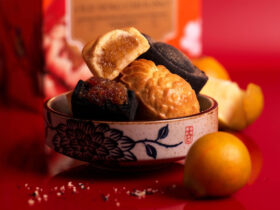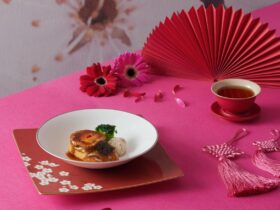Nope, Japanese wines do not ‘taste like water’
By Samantha Francis
A dining companion once remarked that Japanese wines tasted like water in comparison to a Shiraz or Pinot Noir. Little had I realised how sweepingly inaccurate that statement was.

The savoury and salty flavours of the fried items were well balanced by the smooth and citrusy notes from the Suntory Premium Koshu 2013.
Elegant, Fruity Flavours
Japanese wines, as I learnt from a pairing session, are in a different class. Despite lacking the mature heritage of winemaking countries in Europe, premium Japan wineries such as Tomi No Oka are making waves with labels that use 100 per cent domestically-grown grapes.
The wines, cultivated in one of the driest parts of Yamanashi, said to be the perfect climate, lean toward a more delicate and elegant flavour profile. You’ll be able to taste nuances like mellowness and even a refreshing hint of Japanese citrus.
Unsurprisingly, the interesting complexity of these indigenous Japanese varieties makes them perfect for pairing with various seasonal Japanese cuisines.

The Muscat Bailey A is a lighter style of red with a fruity flavour and a distinct mellowness.
Perfect Pairings
Our meal commenced with an appetiser of su miso na no hana (vinegar and miso dressing), deep-fried ika (squid), ebi (fried prawn) and edamame (Japanese stem bean).
The savoury and salty flavours of these fried items were well balanced by the smooth and citrusy notes of the Suntory Premium Koshu 2013 wine. Made with 100 per cent Koshu grapes, the wine’s slight acidity helped to cut through the grease.
A particularly interesting pairing was the assorted sushi platter of chu-toro (medium fatty tuna), hirame (olive flounder), unagi (eel), ebi and tamago (Japanese omelette) with the Suntory Premium Muscat Bailey A 2012. While seafood is commonly paired with white wine, the Muscat Bailey A is a lighter style of red wine with a fruity flavour and distinct mellowness.
 Tomi No Oka Red 2011 is a medium-bodied wine with the fruity aroma of blueberries and prunes.
Tomi No Oka Red 2011 is a medium-bodied wine with the fruity aroma of blueberries and prunes.
Star of the Meal
The Hoba Miso Wagyu was the star of the pairing lunch. The grilled wagyu was exceptionally tender and its beef flavours were complemented by the sweetness from the hoba miso (fermented soy bean paste).
The dish was paired with the Tomi No Oka Red 2011, a medium-bodied wine with the fruity aroma of blueberries and prunes. With its sweet tannins, the wine brought out the rich flavours of the wagyu beautifully.
On the whole, the pairings showed off these Japanese hallmark wines and their versatility in pairing. I left with the desire to explore wines from beyond the usual winemaking regions.
These Japanese wines (from $45-$80) are available at The Beam Cellar, Mountbatten Square, 229 Mountbatten Road, #01-03 to 07 / #01-17 to 19, Singapore 398007.
ADVERTISEMENTS










Leave a Reply